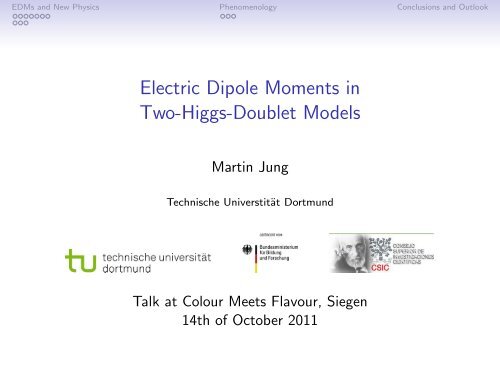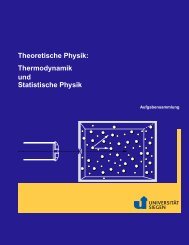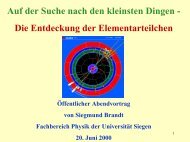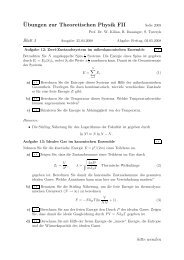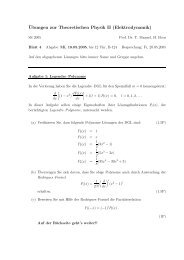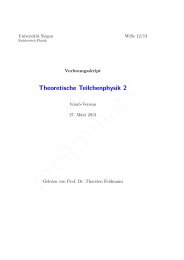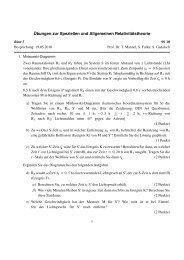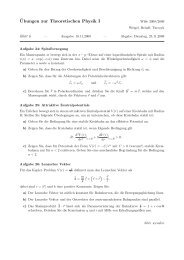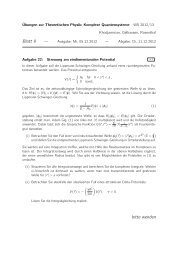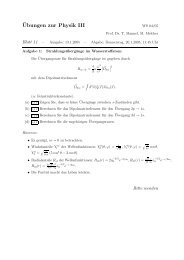Electric Dipole Moments in Two-Higgs-Doublet Models
Electric Dipole Moments in Two-Higgs-Doublet Models
Electric Dipole Moments in Two-Higgs-Doublet Models
You also want an ePaper? Increase the reach of your titles
YUMPU automatically turns print PDFs into web optimized ePapers that Google loves.
EDMs and New Physics Phenomenology Conclusions and Outlook<br />
<strong>Electric</strong> <strong>Dipole</strong> <strong>Moments</strong> <strong>in</strong><br />
<strong>Two</strong>-<strong>Higgs</strong>-<strong>Doublet</strong> <strong>Models</strong><br />
Mart<strong>in</strong> Jung<br />
Technische Universtität Dortmund<br />
Talk at Colour Meets Flavour, Siegen<br />
14th of October 2011
EDMs and New Physics Phenomenology Conclusions and Outlook<br />
Outl<strong>in</strong>e<br />
EDMs and New Physics<br />
Importance of EDMs<br />
<strong>Two</strong>-<strong>Higgs</strong>-<strong>Doublet</strong> <strong>Models</strong><br />
Phenomenology<br />
EDMs <strong>in</strong> 2HDMs<br />
Conclusions and Outlook
EDMs and New Physics Phenomenology Conclusions and Outlook<br />
Importance of EDMs<br />
Flavour-sector of the SM is special (→):<br />
• Unique connection between Flavourand<br />
CP-violation<br />
• FCNCs highly suppressed<br />
• FConserv<strong>in</strong>gNCs with CPV as well!<br />
d SM,CKM<br />
n 10 −32 e cm (Pospelov/Ritz ’05), well below<br />
foreseeable tests<br />
EDMs test sources for CPV to extremely high precision:<br />
• Experimentally e.g. d exp<br />
n 3 × 10 −26 e cm (Baker et al. ’06)<br />
Strong CP problem; below some dynamical solution assumed<br />
Background-free precision-laboratory for NP!
EDMs and New Physics Phenomenology Conclusions and Outlook<br />
EDMs and NP<br />
NP models necessarily <strong>in</strong>volve new sources of CPV:<br />
• Generally (too) large EDMs (“NP models predict EDMs just<br />
below the present limits” always true)<br />
• Limits on FCNCs and EDMs imply highly non-trivial flavourand<br />
CPV-structure<br />
Generic one-loop contributions excluded<br />
(→ SUSY CP-problem)<br />
Sensitivity to two-loop contributions → UV-completion<br />
EDMs important on two levels:<br />
• “Smok<strong>in</strong>g-Gun-level”: Visible EDMs prove for NP<br />
• Quantitative level: Sett<strong>in</strong>g limits/determ<strong>in</strong><strong>in</strong>g parameters<br />
Theory uncerta<strong>in</strong>ties are important!
EDMs and New Physics Phenomenology Conclusions and Outlook<br />
Flavour meets Colour<br />
• Most str<strong>in</strong>gent constra<strong>in</strong>ts stem from neutron and atoms<br />
QCD essential<br />
• Limits usually displayed as allowed regions<br />
Conservative uncerta<strong>in</strong>ty-estimates important<br />
Atomic level<br />
⇓<br />
Nuclear Level<br />
⇓<br />
QCD level<br />
⇓<br />
Effective Theory with (C)EDMs of fermions, O W ,. . .<br />
⇓<br />
Parameters of your favourite NP model<br />
Each step might <strong>in</strong>volve uncerta<strong>in</strong>ties of orders of magnitude!
EDMs and New Physics Phenomenology Conclusions and Outlook<br />
f =u,d,e<br />
Framework<br />
Effective Lagrangian at a hadronic scale:<br />
L = −<br />
∑ [ d<br />
γ<br />
f<br />
2 Oγ f<br />
+ d f<br />
C ]<br />
2 OC f + C W O W + ∑<br />
<strong>in</strong> the operator basis<br />
i,j=(q,l)<br />
C ij O 4f<br />
ij ,<br />
O γ f<br />
= ie ¯ψ f F µν σ µν γ 5 ψ f , O C f = ig s ¯ψ f G µν σ µν γ 5 ψ f ,<br />
O W = + 1 3 f abc G a µν ˜G νβ,b G µ,c<br />
β<br />
, O 4f<br />
ij = ( ¯ψ i ψ i )( ¯ψ j iγ 5 ψ j )<br />
Options for matrix elements:<br />
• Naive dimensional analysis (Georgi/Manohar ’84): a.o. arbitrary<br />
factos of 4π (e.g. Bigi/Uraltsev ’91)<br />
• Baryon χPT : not applicable for all the operators<br />
• QCD sum rules: used here (Pospelov et al.), uncerta<strong>in</strong>ties large<br />
• Ideas, anyone?
EDMs and New Physics Phenomenology Conclusions and Outlook<br />
Theory uncerta<strong>in</strong>ties I<br />
Example: The electron EDM<br />
• Often extracted us<strong>in</strong>g d Tl = C e d e with C e = −585<br />
(Mårtensson-Pendrill, Öster 1987)<br />
• Calculations span C e ∈ [−1041, −179](!) (cancellations)<br />
• Recent results: d Tl ∼ −582(20)d e and ∼ 466(10)d e<br />
(Dzuba/Flambaum ’09, Nataraj et al.’10)<br />
• Furthermore: Four-fermion operators relevant<br />
d Tl = −(529 ± 73)d e − (34 ± 10) GeV e C S<br />
• To obta<strong>in</strong> limit: constra<strong>in</strong>t/assumption needed for C S !
EDMs and New Physics Phenomenology Conclusions and Outlook<br />
Theory uncerta<strong>in</strong>ties II<br />
Example: The EDM of Mercury<br />
• The most precise EDM-limit so far: |d Hg | ≤ 3.1 × 10 −29 e cm<br />
(Griffith et al. ’09)<br />
• However: diamagnetic system<br />
• Shield<strong>in</strong>g efficient → sensitivity ∼ d n , d Tl<br />
• All stages enter:<br />
d Hg<br />
Atomic<br />
= d Hg (S, C S,P ) Nuclear<br />
= d Hg (˜g πNN , C S,P )<br />
QCD<br />
= d Hg (d C f , C qq ′, C S,P )<br />
• Uncerta<strong>in</strong>ties:<br />
Atomic∼ 30%, Nuclear∼ x00%, QCD sum rules∼ 100 − 200%<br />
Constra<strong>in</strong>t on CEDMs not very reliable (1 CV → 1/30 rc → 0 c )<br />
Progress <strong>in</strong> theory needed to fully exploit<br />
precision measurements of EDMs
EDMs and New Physics Phenomenology Conclusions and Outlook<br />
A model-<strong>in</strong>dependent limit on the electron EDM<br />
In general: Too many parameters for model-<strong>in</strong>dependent analysis<br />
Bounds usually obta<strong>in</strong>ed by assum<strong>in</strong>g vanish<strong>in</strong>g cancellations<br />
Electron EDM:<br />
• Bound <strong>in</strong> (Regan et al. ’02): |d e | ≤ 1.6 × 10 −27 (90% CL)<br />
• <strong>Two</strong> shortcom<strong>in</strong>gs: C e = −585 chosen and C S ignored<br />
• First issue addressed already<br />
• Idea for C S : make assumption on a sub-lead<strong>in</strong>g level<br />
1. Use bound on C S from Mercury<br />
2. Use that bound and range for C e to obta<strong>in</strong> limit on d e<br />
• This procedure results <strong>in</strong><br />
|C S | ≤ 2.2 × 10 −13 GeV −2 and<br />
|d e | ≤ 2.8 × 10 −27 e cm (95% CL)<br />
• Robust, model-<strong>in</strong>dependent limt, can be used for NP-bounds
EDMs and New Physics Phenomenology Conclusions and Outlook<br />
Why 2HDM?<br />
Model-<strong>in</strong>dependent analysis: Too many parameters <strong>in</strong> general<br />
Electroweak symmetry break<strong>in</strong>g mechanism unknown yet:<br />
• 1HDM m<strong>in</strong>imal and elegant, but unlikely (SUSY,GUTs,. . . )<br />
• 2HDM “next-to-m<strong>in</strong>imal”:<br />
• ρ-parameter “implies” doublets<br />
• low-energy limit of more complete NP models<br />
Model-<strong>in</strong>dependent element<br />
• simple structure, but <strong>in</strong>terest<strong>in</strong>g phenomenology<br />
• important effects <strong>in</strong> flavour observables
EDMs and New Physics Phenomenology Conclusions and Outlook<br />
General 2HDM:<br />
Lots of 2HDMs. . .<br />
−L q Y<br />
= ¯Q ′ L (Γ 1φ 1 + Γ 2 φ 2 ) d ′ R + ¯Q ′ L (∆ 1 ˜φ 1 + ∆ 2 ˜φ2 ) u ′ R + h.c.<br />
Γ i , ∆ i : Independent 3 × 3 coupl<strong>in</strong>g matrices<br />
Flavour problem: generic coupl<strong>in</strong>gs imply huge NP scale<br />
Some of the many approaches:<br />
• Z 2 (SUSY-motivated, 1 flavour-parameter, no CPV)<br />
• Type III: Y ′<br />
ij ∼ √<br />
mi m j<br />
v 2 (Cheng/Sher ’87)<br />
• 2HDM with MFV (D’Ambrosio et al. ’02):<br />
• EFT framework, unknown coupl<strong>in</strong>gs<br />
• Yukawas rema<strong>in</strong> only source of flavour and CP violation<br />
• Expansion around Type II (as ’02 as well) with phases and<br />
decoupl<strong>in</strong>g (Buras et al. ’10). See also (Paradisi/Straub, Kagan et<br />
al., Botella et al., Feldmann/MJ/Mannel, Colangelo et al., all ’09)<br />
• BGL models (Branco et al. ’96), (Ferreira/Silva ’10), . . .
EDMs and New Physics Phenomenology Conclusions and Outlook<br />
The Aligned two-<strong>Higgs</strong>-doublet model<br />
Alignment condition: Γ 2 = ξ d e −iθ Γ 1 , ∆ 2 = ξ ∗ u e iθ ∆ 1<br />
leads to [Pich/Tuzón ’09]<br />
√<br />
−L q 2<br />
Y ,H<br />
= ± v<br />
H+ (x)ū(x) [ ς d VM d P R − ς u M uV † ]<br />
P L d(x) + h.c.<br />
with complex, observable parameters ς u,d,l , imply<strong>in</strong>g:<br />
• No FCNCs at tree-level<br />
• New sources for CP violation<br />
• Only three complex new parameters (unlike Type III)<br />
• Z 2 models recovered for special values of ς<br />
i ′ s<br />
• Radiative corrections symmetry-protected, of MFV-type (Cvetic<br />
et al. ’98, Braeun<strong>in</strong>ger et al. ’10, MJ/Pich/Tuzón ’10)<br />
• Proposals towards UV-completion (Medeiros Varzielas’11, Serôdio’11)<br />
• 1st term <strong>in</strong> spurion formalism with flavour-bl<strong>in</strong>d phases, w/o<br />
series around type II
EDMs and New Physics Phenomenology Conclusions and Outlook<br />
EDMs <strong>in</strong> 2HDMs<br />
In A2HDM, and most models with effective flavour-suppression:<br />
• One-loop (C)EDMs: controlled (not t<strong>in</strong>y) (e.g. Buras et al. ’10)<br />
• 4-quark operators: small, no tan β 3 -enhancement<br />
<strong>Two</strong>-loop graphs dom<strong>in</strong>ant (We<strong>in</strong>berg ’89, Dicus ’90, Barr/Zee ’90,<br />
Gunion/Wyler ’90)<br />
Aga<strong>in</strong> sensitivity to UV-completion<br />
• Largest charged <strong>Higgs</strong> contribution from We<strong>in</strong>berg diagram<br />
• Barr-Zee(-like) diagrams dom<strong>in</strong>ate neutral <strong>Higgs</strong> exchange<br />
• For neutrals: sum <strong>in</strong>cludes cancellations <strong>in</strong> general
EDMs and New Physics Phenomenology Conclusions and Outlook<br />
Charged <strong>Higgs</strong> <strong>in</strong> the neutron EDM<br />
• <strong>Two</strong>-step match<strong>in</strong>g (Braaten et al., Boyd et al. ’90):<br />
b-CEDM at µ EW → O W at µ b<br />
Absence of strong RGE-suppression for O W<br />
• QCD sum rule estimate for matrix element<br />
|d n | ∼ dn<br />
exp 500 GeV<br />
|Im[ζ d ζ<br />
M<br />
u]|<br />
∗<br />
H ±<br />
From BR(b → sγ) <strong>in</strong> complex ζ d ζ ∗ u-plane:<br />
15<br />
10<br />
5<br />
ImΖuΖ d<br />
⋆ <br />
0<br />
5<br />
10<br />
15<br />
5 0 5 10 15 20 25<br />
ReΖuΖ d ⋆
EDMs and New Physics Phenomenology Conclusions and Outlook<br />
Charged <strong>Higgs</strong> <strong>in</strong> the neutron EDM<br />
• <strong>Two</strong>-step match<strong>in</strong>g (Braaten et al., Boyd et al. ’90):<br />
b-CEDM at µ EW → O W at µ b<br />
Absence of strong RGE-suppression for O W<br />
• QCD sum rule estimate for matrix element<br />
|d n | ∼ dn<br />
exp 500 GeV<br />
|Im[ζ d ζ<br />
M<br />
u]|<br />
∗<br />
H ±<br />
Constra<strong>in</strong>t from neutron EDM on charged <strong>Higgs</strong> contribution:<br />
15<br />
10<br />
5<br />
ImΖuΖ d<br />
⋆ <br />
0<br />
5<br />
10<br />
15<br />
5 0 5 10 15 20 25<br />
ReΖuΖ d ⋆
EDMs and New Physics Phenomenology Conclusions and Outlook<br />
Charged <strong>Higgs</strong> <strong>in</strong> the neutron EDM<br />
• <strong>Two</strong>-step match<strong>in</strong>g (Braaten et al., Boyd et al. ’90):<br />
b-CEDM at µ EW → O W at µ b<br />
Absence of strong RGE-suppression for O W<br />
• QCD sum rule estimate for matrix element<br />
|d n | ∼ dn<br />
exp 500 GeV<br />
|Im[ζ d ζ<br />
M<br />
u]|<br />
∗<br />
H ±<br />
Comb<strong>in</strong>ation of BR(b → sγ) and neutron EDM:<br />
1.5<br />
ImΖuΖ d<br />
⋆ <br />
1.0<br />
0.5<br />
0.0<br />
0.5<br />
1.0<br />
1.5<br />
5 0 5 10 15 20 25<br />
ReΖuΖ d ⋆ <br />
orange: M H ± = 500 GeV<br />
brown: M H ± = 80 GeV<br />
Im(ζ d ζ ∗ u) strongly<br />
constra<strong>in</strong>ed, but not t<strong>in</strong>y
EDMs and New Physics Phenomenology Conclusions and Outlook<br />
Neutral <strong>Higgs</strong> <strong>in</strong> EDMs<br />
• Effect dom<strong>in</strong>ated by Barr-Zee(-like) diagrams<br />
• Non-trivial constra<strong>in</strong>ts for all comb<strong>in</strong>ations apart from Im(y 2 u )<br />
• Here: only results for Thallium, one neutral <strong>Higgs</strong><br />
Paramagnetic atom, EDM dom<strong>in</strong>ated by d e (as shown)<br />
2.0<br />
200<br />
1.5<br />
150<br />
ReylImyu<br />
1.0<br />
Imy l<br />
2 <br />
100<br />
0.5<br />
50<br />
0.0<br />
100 200 300 400 500<br />
0<br />
100 200 300 400 500<br />
MH0 GeV<br />
MH0 GeV<br />
Aga<strong>in</strong> O(1) imag<strong>in</strong>ary parts rema<strong>in</strong> allowed<br />
The A2HDM passes the EDM-test
EDMs and New Physics Phenomenology Conclusions and Outlook<br />
Conclusions and outlook<br />
Conclusions:<br />
• CPV-sector of NP models uniquely constra<strong>in</strong>ed by EDMs<br />
• Quantitative results require close look at theory uncerta<strong>in</strong>ties<br />
• Robust, model-<strong>in</strong>dependent limit on electron EDM:<br />
|d e | ≤ 2.8 × 10 −27 e cm (95% CL)<br />
• 2HDMs active field, new developments<br />
• A2HDM:<br />
• New CPV possible with sufficient FCNC suppression(!)<br />
• Rich phenomenology, only three new flavour-parameters<br />
• Strong (but not “kill<strong>in</strong>g”) constra<strong>in</strong>ts from EDMs<br />
Outlook:<br />
• A2HDM: Additional analyses <strong>in</strong> progress<br />
• Lots of new EDM-results to come, 1 − 3 orders of magnitude<br />
expected with<strong>in</strong> 1-few years<br />
Shortly we might see limits chang<strong>in</strong>g to determ<strong>in</strong>ations
EDMs and New Physics Phenomenology Conclusions and Outlook<br />
Backupslides<br />
• Radiative corrections <strong>in</strong> the A2HDM<br />
• Neutron EDM <strong>in</strong> the A2HDM<br />
• Experimental data used<br />
• Hadronic <strong>in</strong>puts
EDMs and New Physics Phenomenology Conclusions and Outlook<br />
Mercury EDM<br />
(<br />
d Hg = −(1.0 ± 0.3) × 10 −17 e cm (1.0 ± 0.8)0.7 ḡ (0)<br />
)<br />
(1.0 ± 0.9)2.1 ḡ (1)<br />
[<br />
−1.48 C S + 0.09<br />
πNN<br />
(<br />
πNN +<br />
+ (1.0 ± 0.1) × 10 −2 e GeV ×<br />
C P + Z − N )]<br />
A<br />
C ′ P . (1)
EDMs and New Physics Phenomenology Conclusions and Outlook<br />
Radiative corrections <strong>in</strong> the A2HDM<br />
Symmetry structure forces the (one-loop) corrections to be of the<br />
form [MJ/Pich/Tuzón ’10, Cvetic et al. ’98]<br />
L FCNC = C(µ)<br />
4π 2 v 3 (1 + ς∗ u ς d ) ×<br />
× ∑ i<br />
ϕ 0 i (x) {(R i2 + i R i3 ) (ς d − ς u )<br />
[¯dL V † M u M † u VM d d R<br />
]<br />
−<br />
− (R i2 − i R i3 ) (ς ∗ d − ς∗ u ) [<br />
ū L VM d M † d V † M u u R<br />
]}<br />
+ h.c.<br />
• Vanish for Z 2 symmetry<br />
• FCNCs still strongly suppressed<br />
• See also Braeun<strong>in</strong>ger et al. ’10, Ferreira et al. ’10
EDMs and New Physics Phenomenology Conclusions and Outlook<br />
Observables<br />
Observable<br />
Value<br />
|gRR S |τ→µ < 0.72 (95% CL)<br />
Br(τ → µν τ ¯ν µ)<br />
(17.36 ± 0.05) × 10 −2<br />
Br(τ → eν τ ¯ν e)<br />
(17.85 ± 0.05) × 10 −2<br />
Br(τ → µν τ ¯ν µ)/Br(τ → eν τ ¯ν e) 0.9796 ± 0.0039<br />
Br(B → τν)<br />
(1.73 ± 0.35) × 10 −4<br />
Br(D → µν)<br />
(3.82 ± 0.33) × 10 −4<br />
Br(D → τν) ≤ 1.3 × 10 −3 (95% CL)<br />
Br(D s → τν)<br />
(5.58 ± 0.35) × 10 −2<br />
Br(D s → µν)<br />
(5.80 ± 0.43) × 10 −3<br />
Γ(K → µν)/Γ(π → µν) 1.334 ± 0.004<br />
Γ(τ → Kν)/Γ(τ → πν)<br />
(6.50 ± 0.10) × 10 −2<br />
log C 0.194 ± 0.011<br />
Br(B → Dτν)/BR(B → Dlν) 0.392 ± 0.079<br />
Γ(Z → b¯b)/Γ(Z → hadrons) 0.21629 ± 0.00066<br />
Br( ¯B → X sγ) Eγ >1.6GeV<br />
(3.55 ± 0.26) × 10 −4<br />
Br( ¯B → X ce¯ν e)<br />
(10.74 ± 0.16) × 10 −2<br />
∆m B 0<br />
d<br />
(0.507 ± 0.005) ps −1<br />
∆m B 0 s<br />
(17.77 ± 0.12) ps −1<br />
|ɛ K | (2.228 ± 0.011) × 10 −3
EDMs and New Physics Phenomenology Conclusions and Outlook<br />
Hadronic Inputs I<br />
Parameter Value Comment<br />
f Bs (0.242 ± 0.003 ± 0.022) GeV Our average<br />
f Bs /f Bd 1.232 ± 0.016 ± 0.033 Our average<br />
f Ds (0.2417 ± 0.0012 ± 0.0053) GeV Our average<br />
f Ds /f Dd 1.171 ± 0.005 ± 0.02 Our average<br />
f K /f π 1.192 ± 0.002 ± 0.013 Our average<br />
√<br />
f Bs<br />
ˆB B 0 (0.266 ± 0.007 ± 0.032) GeV<br />
√ s √<br />
f Bd<br />
ˆB B 0 /(f Bs<br />
ˆB s B 0 ) 1.258 ± 0.025 ± 0.043<br />
s<br />
ˆB K 0.732 ± 0.006 ± 0.043<br />
|V ud | 0.97425 ± 0.00022<br />
λ 0.2255 ± 0.0010<br />
(1 − |V ud | 2) 1/2<br />
|V ub | (3.8 ± 0.1 ± 0.4) · 10 −3 b → ulν (excl. + <strong>in</strong>cl.)<br />
A 0.80 ± 0.01 ± 0.01 b → clν (excl. + <strong>in</strong>cl.)<br />
¯ρ 0.15 ± 0.02 ± 0.05 Our fit<br />
¯η 0.38 ± 0.01 ± 0.06 Our fit<br />
Table: Input values for the hadronic parameters. The first error denotes<br />
statistical uncerta<strong>in</strong>ty, the second systematic/theoretical.
EDMs and New Physics Phenomenology Conclusions and Outlook<br />
Hadronic Inputs II<br />
Parameter Value Comment<br />
¯m u(2 GeV) (0.00255 + 0.00075<br />
− 0.00105 ) GeV<br />
¯m d (2 GeV) (0.00504 + 0.00096<br />
− 0.00154 ) GeV<br />
¯m s (2 GeV) (0.105 + 0.025<br />
− 0.035 ) GeV<br />
¯m c (2 GeV) (1.27 + 0.07<br />
− 0.11 ) GeV<br />
¯m b (m b ) (4.20 + 0.17<br />
− 0.07 ) GeV<br />
¯m t (m t )<br />
(165.1 ± 0.6 ± 2.1) GeV<br />
δem Kl2/πl2<br />
−0.0070 ± 0.0018<br />
δem τK2/Kl2<br />
0.0090 ± 0.0022<br />
δem τπ2/πl2<br />
0.0016 ± 0.0014<br />
ρ 2 | B→Dlν 1.18 ± 0.04 ± 0.04<br />
∆| B→Dlν 0.46 ± 0.02<br />
f+ Kπ (0) 0.965 ± 0.010<br />
ḡb,SM L −0.42112 + 0.00035<br />
− 0.00018<br />
κ ɛ 0.94 ± 0.02<br />
ḡb,SM R 0.07744 + 0.00006<br />
− 0.00008<br />
Table: Input values for the hadronic parameters. The first error denotes<br />
statistical uncerta<strong>in</strong>ty, the second systematic/theoretical.
EDMs and New Physics Phenomenology Conclusions and Outlook<br />
CKM-fit with<strong>in</strong> the A2HDM<br />
In the A2HDM, the CKM-parameters are determ<strong>in</strong>ed as follows:<br />
• Only the constra<strong>in</strong>ts from |V ub /V cb | and ∆m s /∆m d survive.<br />
• γ from tree-level decays not competitive yet, but excludes 2nd<br />
solution.<br />
• ∆m s /∆m d = ∆m s /∆m d | SM + O<br />
(<br />
ms−m d<br />
M W<br />
ς d<br />
)
EDMs and New Physics Phenomenology Conclusions and Outlook<br />
Statistical Treatment<br />
In this work, the RFit-scheme is used: [Höcker et al., 2001]<br />
• Philosophy: distance from central value has no statistical<br />
mean<strong>in</strong>g for theory errors / large systematics<br />
• This implies that the statistical problem is not well-def<strong>in</strong>ed<br />
Assumption: With<strong>in</strong> a range no<br />
contribution to χ 2 , outside <strong>in</strong>crease<br />
correspond<strong>in</strong>g to statistical error<br />
Choose range conservatively<br />
Theory errors add l<strong>in</strong>early<br />
Averag<strong>in</strong>g different theory-results even less well-def<strong>in</strong>ed...<br />
Theory error at least that of best s<strong>in</strong>gle result<br />
Statistical errors treated “normally”<br />
Here additionally: Criteria from FLAG (where available)
EDMs and New Physics Phenomenology Conclusions and Outlook<br />
b → sγ: Results<br />
However: Correlations are extremely important:<br />
|ς ∗ uς d | vs. M H |ς ∗ uς d | vs. Arg(ς ∗ uς d )<br />
• Constra<strong>in</strong>t much stronger for small <strong>Higgs</strong> masses<br />
• For φ ∼ π constructive, φ ∼ 0 destructive <strong>in</strong>terference<br />
• Implies small effect to LCDA from charged <strong>Higgs</strong><br />
(neutral sector effects might be large: see Buras et al. ’10)
EDMs and New Physics Phenomenology Conclusions and Outlook<br />
Direct CP-asymmetry <strong>in</strong> b → sγ<br />
• Small <strong>in</strong> the SM (Ali et al.’98, Kagan/Neubert ’98, Hurth et al.’05).<br />
See however aga<strong>in</strong> Benzke et al. ’11.<br />
• Potentially large <strong>in</strong> 2HDMs with new CPV (Borzumati/Greub ’98)<br />
• However, BR(b → sγ) constra<strong>in</strong>s the asymmetry strongly:<br />
Compatible with measurement, but enhancement possible<br />
More precise measurement <strong>in</strong>terest<strong>in</strong>g (↦→ SuperB)


